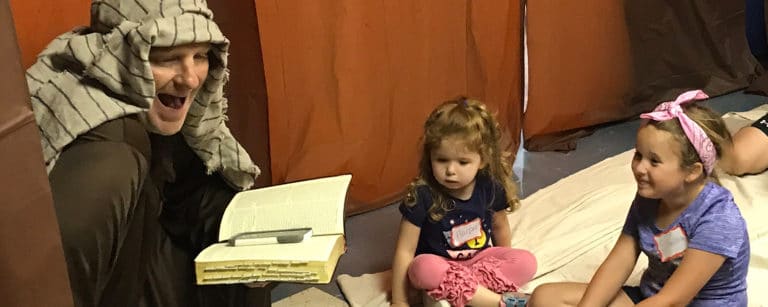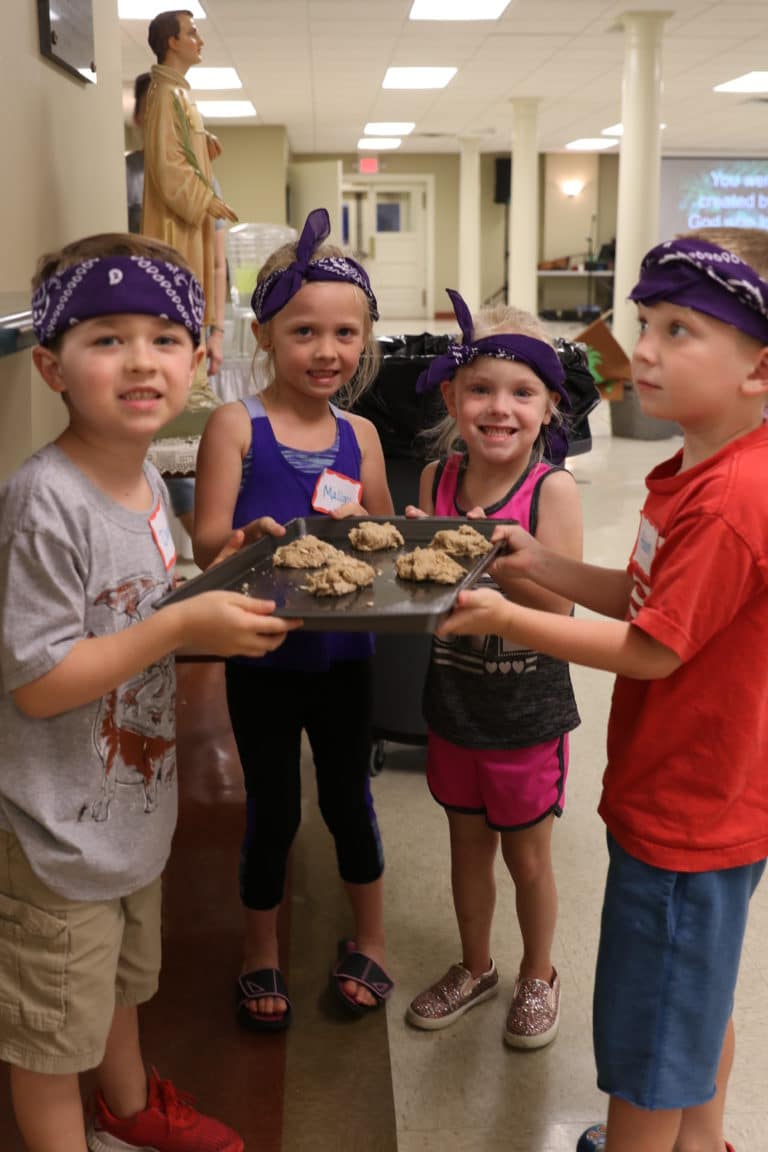Two women with a passion for catechesis find a way to immerse Catholic kids in the Bible

BY ELIZABETH WONG BARNSTEAD, THE WESTERN KENTUCKY CATHOLIC
Debi Hopkins knew something was seriously wrong the year that a little boy at Vacation Bible School said, “You mean these are true stories? These actually happened?”
Stunned, Hopkins realized that this current generation had not learned Bible stories as she had when growing up: “They didn’t know Noah’s ark from Joan of Arc.”
At the time working at St. Mary Magdalene Parish in Sorgho, she discussed the dilemma with parish youth minister, Crissy Stevenson.
Stevenson and Hopkins reflected on the common VBS programs that featured themes like what Hopkins referred to as “Jesus on a spaceship.” For kids who didn’t even know the Bible was factual, adding on kitschy layers just further muddied the waters, they determined.
“We didn’t want to downplay other VBS programs, but our kids needed something basic,” said Hopkins. “We needed meat and potatoes.”
Stevenson recalled her own VBS experience as a child growing up at St. Paul Parish in Princeton. There, the parish was part of a uniquely ecumenical collaboration among the area’s Christian churches to help kids learn about the Bible.
Rather than calling it Vacation Bible School, the collaboration was called Marketplace. It took place in a Bible-times “marketplace” where participants could “meet” and interact with actual Bible characters – portrayed by volunteers.
Stevenson said the program was intended to “immerse you in Bible times,” and credited the method for helping her understand the Bible as a child.
Following this program’s framework, the two women began to research and construct a VBS to truly immerse Catholic children in the Bible. Stevenson created the “infrastructure” of the program; while Hopkins wrote the scripts for the Bible characters.
Hopkins researched the history behind the characters, and then studied children’s religious publishers to see how difficult biblical themes – such as the Fall of Adam and Eve, or the Tower of Babel – were typically presented for little ones.
A key aspect was to form small groups – called “tribes” – of no more than five children each, based on the 12 tribes of Israel.
Unlike VBS programs that separate kids by age, the tribes had a mix of ages in order to help them feel like tiny family units. An adult or teen volunteer assigned to that tribe guided the children through their activities.
Due to the availability of volunteers, St. Mary Magdalene’s program was held from 6-8:15 p.m. each day. Stevenson and Hopkins chose to offer the program for only four days – Monday through Thursday – to avoid crankiness on the part of the young participants, and burnout on the part of the volunteers.

It was critical that the children could interact with the Bible characters and understand that these were real people.
“The characters talk about their lives, and then have time for questions,” said Hopkins.
One of the characters who has made an appearance is Eve – after the Fall. Hopkins said the kids talked to “Eve” and learned about her difficult life after she and Adam ate the fruit and had to leave the Garden of Eden.
Besides highlighting primary characters like Adam, Eve and Noah, they also incorporated minor characters, such as Nimrod, the architect for the ill-fated Tower of Babel.
“They get to see that not everyone in the Bible’s wearing a halo,” said Hopkins.
Hopkins said she hopes that in the future, when these children hear the name of a Bible character, “there’s a familiarity there – that these are true stories and they’re alive in our Catholic tradition.”
Another unique aspect of this curriculum is that the program stretches for a seven-year cycle. The goal is that in the end, children attending every year will have met numerous Bible characters and covered a significant portion of the scriptures.
Hopkins and Stevenson suspect the original marketplace model grew out of a 1950s-era VBS-style program that involved immersing kids in Bible stories, but they have never known for certain.
Regardless, the women emphasized that this was not their original idea: they drew inspiration from many sources.
Stevenson said this type of VBS doesn’t have a theme – apart from “the Bible,” but what they hope the children take away is “You were created by a God who loves you, and that God takes care of us.”
Stevenson now serves as the youth minister at St. Stephen Cathedral, where she introduced the immersive VBS program this summer. Stevenson said the program was a great success and even heard from a mom whose four-year-old was still singing the songs and talking about the stories she learned, weeks after VBS had ended.
Hopkins now works at St. Martin Parish in Rome, as the director of religious education, but she was happy to help out at St. Mary Magdalene’s VBS in July.
Looking at the diocese’s ongoing “Living as Missionary Disciples” evangelization initiative, Stevenson has reflected on how this matches up with their focus helping children have personal encounters with scriptural characters.
“We’d been doing evangelization without even knowing it,” she said.
Originally printed in the August 2019 issue of The Western Kentucky Catholic.
Copyright © 2019 Diocese of Owensboro/The Western Kentucky Catholic
